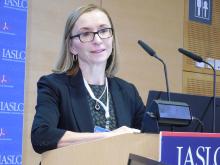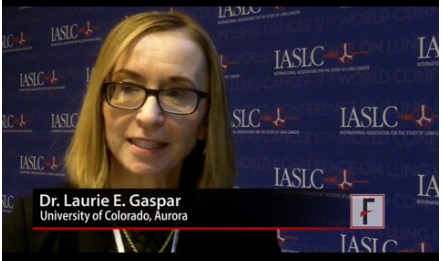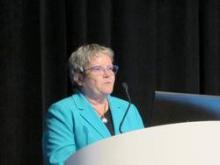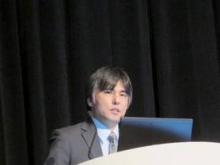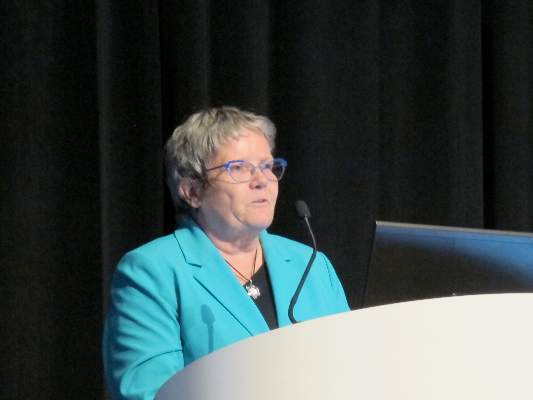User login
VIDEO: Decision aids can relay relative risks to lung cancer patients
VIENNA – Many lung cancer patients would like to work with their physicians to reach a shared decision about their care, but often feel inadequately informed to comfortably participate in the decision process.
Patient decision aids offer a way to address this knowledge and participation gap, Laurie E. Gaspar, MD, said in a video interview at the World Conference on Lung Cancer, sponsored by the International Association for the Study of Lung Cancer.
The video associated with this article is no longer available on this site. Please view all of our videos on the MDedge YouTube channel
She and her associates have run an online survey that so far has received responses from 196 lung cancer patients, caregivers of patients, or significant others of patients. One hundred seventeen (60%) said that they faced a difficult management decision, but more than half these patients said they felt they had inadequate information to make their decision. The most popular form of decision making was a shared decision with their physician, favored by 73% of the respondents, but only about half the patients believed they had actually participated in a shared-decision process with their physician, reported Dr. Gaspar, professor of radiation oncology at the University of Colorado in Aurora.
“A majority of the patients felt there was a problem in not having sufficient information, and a majority want to make decisions in a shared way,” she explained.
[email protected]
On Twitter @mitchelzoler
VIENNA – Many lung cancer patients would like to work with their physicians to reach a shared decision about their care, but often feel inadequately informed to comfortably participate in the decision process.
Patient decision aids offer a way to address this knowledge and participation gap, Laurie E. Gaspar, MD, said in a video interview at the World Conference on Lung Cancer, sponsored by the International Association for the Study of Lung Cancer.
The video associated with this article is no longer available on this site. Please view all of our videos on the MDedge YouTube channel
She and her associates have run an online survey that so far has received responses from 196 lung cancer patients, caregivers of patients, or significant others of patients. One hundred seventeen (60%) said that they faced a difficult management decision, but more than half these patients said they felt they had inadequate information to make their decision. The most popular form of decision making was a shared decision with their physician, favored by 73% of the respondents, but only about half the patients believed they had actually participated in a shared-decision process with their physician, reported Dr. Gaspar, professor of radiation oncology at the University of Colorado in Aurora.
“A majority of the patients felt there was a problem in not having sufficient information, and a majority want to make decisions in a shared way,” she explained.
[email protected]
On Twitter @mitchelzoler
VIENNA – Many lung cancer patients would like to work with their physicians to reach a shared decision about their care, but often feel inadequately informed to comfortably participate in the decision process.
Patient decision aids offer a way to address this knowledge and participation gap, Laurie E. Gaspar, MD, said in a video interview at the World Conference on Lung Cancer, sponsored by the International Association for the Study of Lung Cancer.
The video associated with this article is no longer available on this site. Please view all of our videos on the MDedge YouTube channel
She and her associates have run an online survey that so far has received responses from 196 lung cancer patients, caregivers of patients, or significant others of patients. One hundred seventeen (60%) said that they faced a difficult management decision, but more than half these patients said they felt they had inadequate information to make their decision. The most popular form of decision making was a shared decision with their physician, favored by 73% of the respondents, but only about half the patients believed they had actually participated in a shared-decision process with their physician, reported Dr. Gaspar, professor of radiation oncology at the University of Colorado in Aurora.
“A majority of the patients felt there was a problem in not having sufficient information, and a majority want to make decisions in a shared way,” she explained.
[email protected]
On Twitter @mitchelzoler
At WCLC 2016
Key clinical point:
Major finding: A shared-decision process received support from 73% of patients, but just half believed they participated in shared decision making.
Data source: Online survey completed by 196 lung cancer patients, caregivers or significant others.
Disclosures: Dr. Gaspar had no disclosures.
Vaccines targeting MUC1 show activity against NSCLC
DENVER – Checkpoint inhibitors get all the love these days, but other forms of immunotherapy, delivered alone or in combination with conventional chemotherapy, also show promising activity against non–small cell lung cancer, investigators report.
Two recombinant vaccines targeted against the tumor-associated antigen MUC1 (mucin 1, cell surface–associated) were associated with improved progression-free survival (PFS) and/or overall survival (OS).
A modified version of a vaccinia virus strain, labeled TG4010, when delivered in combination with chemotherapy to patients with stage IV NSCLC, improved both PFS and OS, particularly for those with low baseline levels of triple-positive activated lymphocytes (TrPAL), reported Dr. Elisabeth Quoix from Hospital Civil in Strasbourg, France.
“The future development of TG4010 is already planned in combination with chemotherapy and with immune checkpoint inhibitors,” Dr. Quoix said here at a world lung cancer conference sponsored by the International Association for the Study of Lung Cancer.
In a separate study, a dendritic cell-based immunotherapeutic vaccine was associated with good overall survival among patients who received six or more biweekly vaccinations, said Dr. Koji Teramoto from the Shiga University of Medical Science in Otsu, Japan.
Recombinant vaccine
TG4010 is a recombinant version of the Vaccinia virus Ankara strain that has been modified to carry coding sequences targeting MUC1 and interleukin-2. MUC1 receptors have been detected in various cancers, including NSCLC.
Dr. Quoix reported results of the phase IIb stage of a placebo-controlled study comparing a platinum-based chemotherapy doublet plus TG4010 or placebo in 222 patients with previously untreated stage IV NSCLC. Patients were stratified prior to randomization according to low or high TrPAL groups, with low TrPAL defined as a value at or below the upper limit of normal, based on a cutoff value obtained from 369 healthy volunteers.
Among patients with low TrPAL after 24 months of follow-up, the median PFS was 5.8 months for those on the TG4010-chemotherapy combination, compared with 5.0 months for those on chemotherapy with placebo vaccination. The hazard ratio (HR) favoring the addition of the vaccine in this group was 0.66 (P = .0104). Overall PFS rates at 24 months were 33% and 20%, respectively.
Overall survival was also significantly better among patients with low TrPAL who received the vaccine, with a median OS of 13.0 months, compared with 10.4 months for placebo-treated controls (HR, 0.67; P = .0183). In this group, 18-month OS rates were 39% and 30%, respectively.
Among patients with high TrPAL, however, the addition of TG4010 to chemotherapy did not improve either PFS or OS, Dr. Quoix reported.
Dendritic cell vaccine
Dr. Teramoto and his colleagues delivered the dendritic cell vaccine to 41 patients with advanced NSCLC refractory to standard therapy.
The technique involves collection of patients’ peripheral blood mononuclear cells, inducing differentiation of the cells into helper T cells with interleukin 4, expanding the population with granulocyte-macrophage colony-stimulating factor, pulsing them with MUC1 peptides, and then administering the treated cells via subcutaneous injections delivered once every 2 weeks.
Median survival time after the first vaccination was 7.4 months, and the 1-year survival rate was 29.3%.
Of the 41 patients, 29 (70%) received more than six vaccinations, and for these patients, the median survival time from the start of vaccination was 10.1 months, and the 1-year survival rate was 41.4%.
Clinical responses after six vaccinations included 12 cases of stable disease, and 17 with disease progression, for a disease control rate of 41.4% (as assessed according to Response Evaluation Criteria in Solid Tumors).
Dr. Teramoto noted that it generally takes several months to induce antitumor effects with vaccine immunotherapy. The vaccine appears to be most effective in patients with immune-related adverse events and in those with higher peripheral lymphocyte levels (20% and higher), he said, suggesting that peripheral lymphocyte levels could serve in patient selection.
Dr. Johan Vansteenkiste from the University Hospitals Leuven, Belgium, the invited discussant, commented that the TG4010 phase IIb results are promising and indicate that further planned development of the concept is warranted. On the other hand, the dendritic cell vaccine is interesting, but “it’s too early to comment,” he said.
DENVER – Checkpoint inhibitors get all the love these days, but other forms of immunotherapy, delivered alone or in combination with conventional chemotherapy, also show promising activity against non–small cell lung cancer, investigators report.
Two recombinant vaccines targeted against the tumor-associated antigen MUC1 (mucin 1, cell surface–associated) were associated with improved progression-free survival (PFS) and/or overall survival (OS).
A modified version of a vaccinia virus strain, labeled TG4010, when delivered in combination with chemotherapy to patients with stage IV NSCLC, improved both PFS and OS, particularly for those with low baseline levels of triple-positive activated lymphocytes (TrPAL), reported Dr. Elisabeth Quoix from Hospital Civil in Strasbourg, France.
“The future development of TG4010 is already planned in combination with chemotherapy and with immune checkpoint inhibitors,” Dr. Quoix said here at a world lung cancer conference sponsored by the International Association for the Study of Lung Cancer.
In a separate study, a dendritic cell-based immunotherapeutic vaccine was associated with good overall survival among patients who received six or more biweekly vaccinations, said Dr. Koji Teramoto from the Shiga University of Medical Science in Otsu, Japan.
Recombinant vaccine
TG4010 is a recombinant version of the Vaccinia virus Ankara strain that has been modified to carry coding sequences targeting MUC1 and interleukin-2. MUC1 receptors have been detected in various cancers, including NSCLC.
Dr. Quoix reported results of the phase IIb stage of a placebo-controlled study comparing a platinum-based chemotherapy doublet plus TG4010 or placebo in 222 patients with previously untreated stage IV NSCLC. Patients were stratified prior to randomization according to low or high TrPAL groups, with low TrPAL defined as a value at or below the upper limit of normal, based on a cutoff value obtained from 369 healthy volunteers.
Among patients with low TrPAL after 24 months of follow-up, the median PFS was 5.8 months for those on the TG4010-chemotherapy combination, compared with 5.0 months for those on chemotherapy with placebo vaccination. The hazard ratio (HR) favoring the addition of the vaccine in this group was 0.66 (P = .0104). Overall PFS rates at 24 months were 33% and 20%, respectively.
Overall survival was also significantly better among patients with low TrPAL who received the vaccine, with a median OS of 13.0 months, compared with 10.4 months for placebo-treated controls (HR, 0.67; P = .0183). In this group, 18-month OS rates were 39% and 30%, respectively.
Among patients with high TrPAL, however, the addition of TG4010 to chemotherapy did not improve either PFS or OS, Dr. Quoix reported.
Dendritic cell vaccine
Dr. Teramoto and his colleagues delivered the dendritic cell vaccine to 41 patients with advanced NSCLC refractory to standard therapy.
The technique involves collection of patients’ peripheral blood mononuclear cells, inducing differentiation of the cells into helper T cells with interleukin 4, expanding the population with granulocyte-macrophage colony-stimulating factor, pulsing them with MUC1 peptides, and then administering the treated cells via subcutaneous injections delivered once every 2 weeks.
Median survival time after the first vaccination was 7.4 months, and the 1-year survival rate was 29.3%.
Of the 41 patients, 29 (70%) received more than six vaccinations, and for these patients, the median survival time from the start of vaccination was 10.1 months, and the 1-year survival rate was 41.4%.
Clinical responses after six vaccinations included 12 cases of stable disease, and 17 with disease progression, for a disease control rate of 41.4% (as assessed according to Response Evaluation Criteria in Solid Tumors).
Dr. Teramoto noted that it generally takes several months to induce antitumor effects with vaccine immunotherapy. The vaccine appears to be most effective in patients with immune-related adverse events and in those with higher peripheral lymphocyte levels (20% and higher), he said, suggesting that peripheral lymphocyte levels could serve in patient selection.
Dr. Johan Vansteenkiste from the University Hospitals Leuven, Belgium, the invited discussant, commented that the TG4010 phase IIb results are promising and indicate that further planned development of the concept is warranted. On the other hand, the dendritic cell vaccine is interesting, but “it’s too early to comment,” he said.
DENVER – Checkpoint inhibitors get all the love these days, but other forms of immunotherapy, delivered alone or in combination with conventional chemotherapy, also show promising activity against non–small cell lung cancer, investigators report.
Two recombinant vaccines targeted against the tumor-associated antigen MUC1 (mucin 1, cell surface–associated) were associated with improved progression-free survival (PFS) and/or overall survival (OS).
A modified version of a vaccinia virus strain, labeled TG4010, when delivered in combination with chemotherapy to patients with stage IV NSCLC, improved both PFS and OS, particularly for those with low baseline levels of triple-positive activated lymphocytes (TrPAL), reported Dr. Elisabeth Quoix from Hospital Civil in Strasbourg, France.
“The future development of TG4010 is already planned in combination with chemotherapy and with immune checkpoint inhibitors,” Dr. Quoix said here at a world lung cancer conference sponsored by the International Association for the Study of Lung Cancer.
In a separate study, a dendritic cell-based immunotherapeutic vaccine was associated with good overall survival among patients who received six or more biweekly vaccinations, said Dr. Koji Teramoto from the Shiga University of Medical Science in Otsu, Japan.
Recombinant vaccine
TG4010 is a recombinant version of the Vaccinia virus Ankara strain that has been modified to carry coding sequences targeting MUC1 and interleukin-2. MUC1 receptors have been detected in various cancers, including NSCLC.
Dr. Quoix reported results of the phase IIb stage of a placebo-controlled study comparing a platinum-based chemotherapy doublet plus TG4010 or placebo in 222 patients with previously untreated stage IV NSCLC. Patients were stratified prior to randomization according to low or high TrPAL groups, with low TrPAL defined as a value at or below the upper limit of normal, based on a cutoff value obtained from 369 healthy volunteers.
Among patients with low TrPAL after 24 months of follow-up, the median PFS was 5.8 months for those on the TG4010-chemotherapy combination, compared with 5.0 months for those on chemotherapy with placebo vaccination. The hazard ratio (HR) favoring the addition of the vaccine in this group was 0.66 (P = .0104). Overall PFS rates at 24 months were 33% and 20%, respectively.
Overall survival was also significantly better among patients with low TrPAL who received the vaccine, with a median OS of 13.0 months, compared with 10.4 months for placebo-treated controls (HR, 0.67; P = .0183). In this group, 18-month OS rates were 39% and 30%, respectively.
Among patients with high TrPAL, however, the addition of TG4010 to chemotherapy did not improve either PFS or OS, Dr. Quoix reported.
Dendritic cell vaccine
Dr. Teramoto and his colleagues delivered the dendritic cell vaccine to 41 patients with advanced NSCLC refractory to standard therapy.
The technique involves collection of patients’ peripheral blood mononuclear cells, inducing differentiation of the cells into helper T cells with interleukin 4, expanding the population with granulocyte-macrophage colony-stimulating factor, pulsing them with MUC1 peptides, and then administering the treated cells via subcutaneous injections delivered once every 2 weeks.
Median survival time after the first vaccination was 7.4 months, and the 1-year survival rate was 29.3%.
Of the 41 patients, 29 (70%) received more than six vaccinations, and for these patients, the median survival time from the start of vaccination was 10.1 months, and the 1-year survival rate was 41.4%.
Clinical responses after six vaccinations included 12 cases of stable disease, and 17 with disease progression, for a disease control rate of 41.4% (as assessed according to Response Evaluation Criteria in Solid Tumors).
Dr. Teramoto noted that it generally takes several months to induce antitumor effects with vaccine immunotherapy. The vaccine appears to be most effective in patients with immune-related adverse events and in those with higher peripheral lymphocyte levels (20% and higher), he said, suggesting that peripheral lymphocyte levels could serve in patient selection.
Dr. Johan Vansteenkiste from the University Hospitals Leuven, Belgium, the invited discussant, commented that the TG4010 phase IIb results are promising and indicate that further planned development of the concept is warranted. On the other hand, the dendritic cell vaccine is interesting, but “it’s too early to comment,” he said.
AT THE IASLC WORLD CONFERENCE
Key clinical point: Therapeutic vaccines targeting MUC1 show clinical activity against non–small cell lung cancer.
Major finding: Overall survival among patients with low levels of triple-positive activated lymphocytes (TrPAL) treated with chemotherapy and the TG4010 vaccine was 13.0 months, compared with 10.4 months for chemo/placebo-treated controls.
Data source: Retrospective analysis of a randomized clinical trial in 222 patients with advanced NSCLC; open-label prospective study in 41 patients with NSCLC.
Disclosures: The TG4010 study was supported by Transgene. Dr. Quoix disclosed financial ties with various companies other than Transgene, Dr. Teramato did not disclose the funding source for the dendritic vaccine study, but reported having no conflicts of interest. Dr. Vansteenkiste disclosed serving as a consultant and speaker for several companies, but not Transgene.
